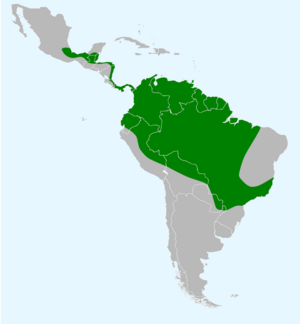Giant cowbird facts for kids
Quick facts for kids Giant cowbird |
|
|---|---|
 |
|
| M. o. oryzivorus in Colombia | |
| Conservation status | |
| Scientific classification | |
| Genus: |
Molothrus
|
| Species: |
oryzivorus
|
 |
|
| Range of M. oryzivorus. | |
| Synonyms | |
|
Scaphidura oryzivora |
|
The giant cowbird (Molothrus oryzivorus) is a large passerine bird, which means it's a type of perching bird. It belongs to the New World family Icteridae, which includes orioles and blackbirds. These birds live from southern Mexico all the way down to northern Argentina, and also on the islands of Trinidad and Tobago. What makes the giant cowbird special is that it's a brood parasite. This means it lays its eggs in the nests of other birds, letting them raise its young!
Contents
About the Giant Cowbird's Name
The giant cowbird got its official name in 1788 from a German scientist named Johann Friedrich Gmelin. He first put it in the same group as orioles. The name oryzivorus comes from Latin words meaning "rice" and "eating." So, its name basically means "rice-eating."
Today, the giant cowbird is one of six types of cowbirds in the group called Molothrus. This group was named in 1832 by William Swainson.
Giant Cowbird Subspecies
There are two main types, or subspecies, of the giant cowbird:
- M. o. impacifus (named by James L. Peters in 1929) – These live from eastern Mexico to western Panama.
- M. o. oryzivorus (named by Johann Friedrich Gmelin in 1788) – These are found from central Panama down to Peru, Bolivia, and northern Argentina.
Where Giant Cowbirds Live
Giant cowbirds like to live in open woodlands and farm areas that have large trees. What's interesting is that they are the only type of cowbird that can also be found deep inside forests.
What Giant Cowbirds Look Like
Male giant cowbirds are about 34 centimeters (13 inches) long. They weigh between 174 and 242 grams (6 to 8.5 ounces). They are a shiny black color. They have a long tail, a long beak, and a small head. Males also have a special neck ruff that they can puff out when they want to show off.
Female giant cowbirds are smaller than males. They are about 29 centimeters (11 inches) long and weigh between 144 and 167 grams (5 to 5.9 ounces). Females are not as shiny as males. They also don't have the neck ruff, which makes their heads look less small. Young male cowbirds look similar to adult males but are browner. Their beaks are pale, not black.
Giant Cowbird Sounds
These birds are usually pretty quiet, especially for a bird in their family. But the male giant cowbird has a loud, screechy whistle. It sounds like shweeaa-tpic-tpic. Their regular call is a sharp chek-chik. They are also very good at copying other bird sounds.
Giant Cowbird Behavior
Reproduction and Brood Parasitism
Like other cowbirds, the giant cowbird is a brood parasite. This means the female lays her eggs in the nests of other birds. She often chooses the nests of oropendolas and caciques.
Giant cowbird eggs come in two types. Some are whitish with no spots. Others are pale blue or green with dark spots and blotches. The cowbird does not destroy the host bird's eggs or chicks.
The birds they parasitize often build their nests close together in groups. These host birds protect their nests very well. So, even a large and brave bird like the giant cowbird has to search a wide area to find enough nests to lay its eggs in. Sometimes, several giant cowbird eggs might be laid in just one host nest.
What Giant Cowbirds Eat
Giant cowbirds are social birds and often feed together. They mostly eat insects. They also eat some seeds, including rice. They look for food on the ground or in trees.
They also search for fruit, nectar, and small arthropods (like insects and spiders) near lakes and rivers. You might also find them looking for food in banana plantations and corn fields. Unlike some of their relatives, they rarely sit on cattle. However, in Brazil, they will ride on capybaras. They do this to pick off ticks or horse flies from the capybaras.


